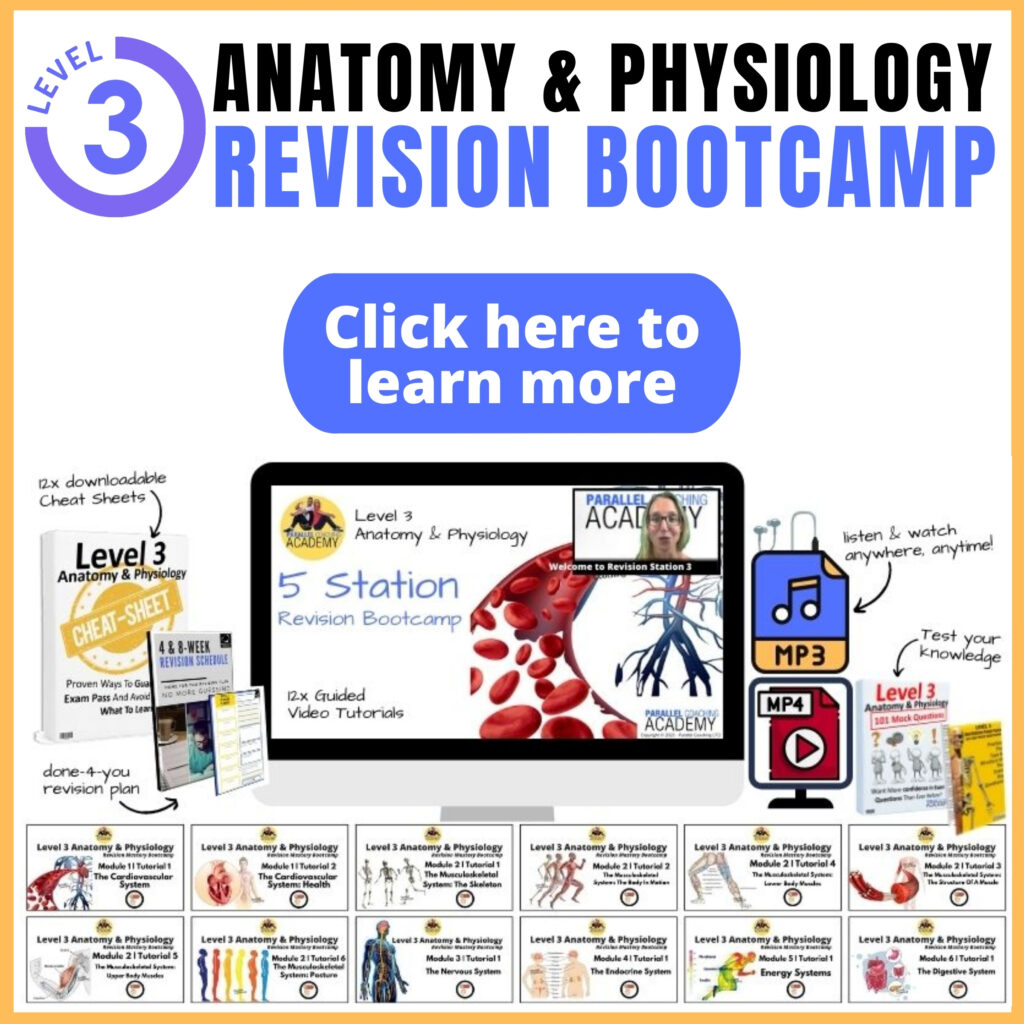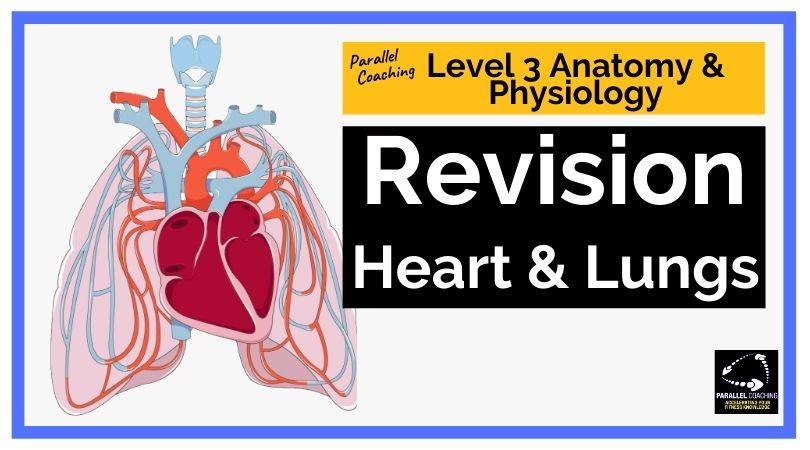This blog will teach you all you need to know about the flow of blood around the Heart and Lungs for your Level 3 Anatomy and Physiology revision.
You’ll discover:
- What to expect on your Level 3 anatomy and physiology exam
- Why FitPros find the heart and lungs hard to revise
- A 3-minute video tutorial showing the flow of blood around the heart, lungs and body to simplify learning
- 15-minute revision task
- The difference between Arteries and Veins
- The flow of oxygenated blood
- The flow of deoxygenated blood
- How to remember the difference between Tricuspid and Bicuspid Valves
- Three Example Mock Question to help your Level 3 Anatomy and Physiology Revision
What to expect in your Level 3 Anatomy and Physiology exam
The Level 3 Anatomy exam will usually have 40 questions, of which you can expect 3-8 questions relating to the heart and lungs.
This means that there are usually 2-3 questions that will directly test your knowledge on the blood flow through the heart and lungs.
Why FitPros find the heart and lungs hard to revise
The blood flow around the Heart and Lungs is notoriously claimed to be one of the hardest topics within the Level 3 Anatomy and Physiology syllabus, so you are not alone if you find this area difficult to understand.
Unlike other areas of anatomy (like muscles), we never get to see our heart move, which makes it feel theoretical. It may also feel like this is less directly related to training clients as a FitPro.
Although you might not actually be quoting the heart valves and blood flow with your clients, the knowledge of this is foundational and absolutely crucial in order to understand the demand and stress we place on the heart in exercise.
It can be difficult to learn the order of blood flow by trying to recall it word for word, instead it can be much easier if you have a map drawn out and someone walks you through it step by step
That’s what we do in this quick 3-minute video tutorial to teach you the blood flow through the heart and lungs
Level 3 Anatomy and Physiology Revision – heart and lungs
Quick 15-minute task:
Watch the three-minute video above and replicate in your revision notes TWICE,
practice the route the blood flows through our circulatory system.
Its kinda like practicing a route you will take by looking at the road map several times
Read the below info to add perspective to your studies and jot down the key revision tips in your notes.
The difference between Arteries and Veins:
Arteries always go away from the heart: A = Away
Veins always go into the heart: the Ve IN to the heart

The flow of oxygenated blood
Oxygenated blood travels to the heart via the Pulmonary Vein and enters the heart through the left Atria.
This chamber collects oxygenated blood from the lungs. Blood now passes through the Bicuspid valve or mitral valve into the left ventricle.
This valve prevents blood from flowing back to the atria as the pressure rises and forces them to shut as the ventricles contract.
The left ventricle increased in pressure and forces blood out to the body via the Aorta. Initially, arteries that stem of the Aorta back to the heart are called Coronary Arteries.
Like any other tissue, the heart requires a constant supply of oxygen and nutrients.
As blood continues through the Aorta into the body’s arteries.
Arteries have a robust design, with thick walls, great elastic fibres and smooth muscle able to withstand large pressures during ventricular contraction.
This elastic recoil helps facilitate the onward movement of the blood. Further along the circulation, the larger elastic arteries give way to medium-sized arteries, in which a greater proportion of smooth muscle is evident.
Totora and Grabowski (2002) report that these larger amounts of smooth muscle allow for greater vasoconstriction and vasodilation; this adjusts the rate of blood flow to suit the needs of the structure supplied.
As the arteries branch and subdivide, they become smaller.
The smallest of these arteries are the arterioles. Although microscopic, they still contain smooth muscle and elastic fibres, albeit in relatively small amounts. The purpose of arterioles is to regulate blood flow to the capillary beds.
Eventually, the few sparse elastics and muscle fibres of the arterioles disappear, leaving a capillary, which is comprised of only a single layer of cells.
The walls of capillaries are microscopically thin, which allows the efficient exchange of nutrients and waste products between the circulating blood and the body’s cells.
Just about every cell in the body will have a capillary nearby, although areas of high metabolic activity will tend to have a higher density. It is also worth noting that exercise will increase capillary density in rained muscles.
It is here that oxygen is delivered to the working muscle and carbon dioxide is picked up to return back to the heart.
Just like in the lungs, the capillaries are extremely thin, thus allowing oxygen and carbon dioxide to diffuse easily in and out.
The flow of de-oxygenated blood
Once having picked up carbon dioxide the role of the circulatory system is to return back to the heart and the lungs to expel the carbon dioxide out through the nose and mouth.
The journey starts in the capillaries of the muscle and then moves into venules, which are small veins. As with arterioles, they have small amount of smooth muscle and elastic fibres. Their main function is to drain the blood from the capillary beds and into the veins.
As venules connect to other venules, larger vessels are formed called veins. The pressure of blood within the veins is relatively low, and whilst veins are comprised of the same basic constituents as arteries (i.e. smooth muscle and elastic fibres), the proportions tend to be lower when compared to an artery of a smaller size.
One of the major distinguishing features of veins is that they are equipped with non-return valves.
These are needed because blood pressure in the veins may be insufficient to overcome gravity, thus valves help prevent reversed blood flow or pooling if blood in the limbs.
Blood re-enters the heart on the right side into the right Atria, another blood collecting chamber only this time with di-oxygenated blood. Blood passes down into the right ventricle via the tricuspid valve.
How to remember the difference between Tricuspid and Bicuspid Valves
Tricuspid valve is on the right side of the heart as the word tricuspid has an ‘R’ in it. Whereas bicuspid does not.
The right ventricle pumps blood into the pulmonary artery and de-oxygenated blood makes its final journey to the lungs, whereby carbon dioxide diffuses into the alveoli and reverses the journey as mentioned earlier.
Test your knowledge with today’s mock questions:
[NOTE: The answers are below the 3rd questions]
1. Which chamber of the heart pumps deoxygenated blood?
A. Left Atrium
B. Right Atrium
C. Left Ventricle
D. Right Ventricle
2. Which is the correct flow of blood?
A. Pulmonary artery, left ventricle, left atrium, aorta
B. Pulmonary vein, left atrium, left ventricle, aorta
C. Vena Cava, left atrium, left ventricle, pulmonary artery
D. Vena Cava, left ventricle, left atrium, pulmonary vein
3. Which valve is responsible for preventing backflow between the left atrium and the left ventricle?
A. Tricuspid Valve
B. Aortic Valve
C. Bicuspid Valve
D. Pulmonary Valve
What’s the CORRECT answer?
Answers to the mock questions are :
Question 1= D, Question 2 = B, Question 3 = C
If you want more mock questions like this, then you can download more Free Mock Questions: DOWNLOAD NOW
Need More Help with your Level 3 Anatomy and Physiology Revision?
Discover How 6500+ Fitpros In Training Are Walking Into Their Exam With Confidence And Guaranteeing A Pass
Are you tired of staring at your manual and not knowing where to start?
Our revision mastery bootcamp breaks everything down into a clear and easy to follow structure.
You can download the videos to MP3 and MP4 to slice your revision time in half and finally understand the key principles of exercise.
This is not another course with more exams – it HELPS pass the course you’re already enrolled on!
“EVERYTHING You Need To Learn, Revise And Pass Your Fitness Exam”
If you want to get your revision structured, learn everything you need to know and feel confident on exam day, then click the link below:
https://courses.parallelcoaching.co.uk/products/level-3-anatomy–physiology-revision-bootcamp

Dedicated to More
Hayley “Level 3 anatomy and physiology revision” Bergman
Parallel Coaching
P.S. You can also find us on the following platforms:
Instagram: Follow Now
Facebook: Like Our Page
Twitter: Tweet Us
YouTube: Subscribe Here
More Anatomy Revision Blogs: HERE

